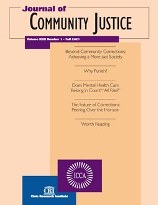Complete Issue
Author: Don Evans.
Source: Volume 17, Number 04, Summer 2008 , pp.1-30(30)

< previous article |return to table of contents
Abstract:
The articles in this issue of JCC cover a wide range of issues and ideas and have a bearing on some of matters raised above. The ideas and information contained in the articles can assist us in our advocacy for community-based corrections and for advancing the cause of evidence-based programming. The articles cover issues related to philosophy and ideology with regard to corrections in general, as well as programs, policies, and practices specific to community corrections. The first article, by Dr. David Wilson, is the published version of his address to the Abolition Conference held at King’s College, London, England, in July 2008. Wilson proposes two interesting concepts relating to the issue of the increase in incarceration rates in the United Kingdom: The development of a correctional skepticism; and the promotion of emotional stories about correctional impacts on offenders, families, and communities. Wilson makes a passionate plea for like-minded people to work to create alternate public space to get out the message that prisons are really not working. His views should, at a minimum, stimulate our thinking about what is possible and practical in telling the story of community corrections. In August 2008, I had the opportunity to moderate the panel on the “End of Corrections as We Know It” presented at the American Correctional Association Congress by Don Head, commissioner of Corrections in Canada, and Mr. Tony Cameron, president of the International Corrections and Prison Association and the former chief of the Scottish Prison Service. Mr. Head’s presentation dealt with the efforts to implement the recommendations contained in the Roadmap to Strengthening Public Safety, a report commissioned by the Canadian government to review practices and policies in the Correctional Service of Canada. Mr. Cameron presented the results of the work of the Scottish Prisons Commission, which had just been released. Dr. Robin Wilson compares and contrasts the two reports and notes that both reports start from the same premise—namely, that something is wrong with the correctional system in each country. The reports diverge in the proposed solutions. The Canadian report moves to strengthen the correctional system, while the Scottish proposals look more broadly at an effort to improve the social environment. Personally, I find the proposals in the Scottish Prison Commission report more plausible—and certainly friendlier to community approaches to public safety—than those in the Canadian approach. The next three articles are discussions about interventions that relate to working with offenders in the community. Leonard Sipes looks at the role of local law enforcement in the provision of services to offenders and the community relative to reentry initiatives. This front end of the justice system is often overlooked in discussions about back-end reentry programs. Alliances and partnerships between community-based correctional agencies and local law enforcement can assist in reducing recidivism. Professor Fergus McNeil of the Glasgow School of Social Work at the Universities of Glasgow and Strathclyde invites us to examine the desistance paradigm for offender management. He suggests that we should think less about how practice can be constructed and consider how change should be understood. McNeil believes that understanding the human processes and social contexts in and through which change occurs is a necessary precursor to developing an effective practice model. This is a concise and clear presentation of what is becoming an important development in understanding what might encourage offenders to change their behavior. I think that we are likely to see more discussion of the processes of desistance and an increase in the research literature leading to helpful additions to our practice knowledge. Mathew Logan, in his contribution, looks at the issue of IT literacy as an essential skill and applies IT to the programming and preparation of offenders returning to the community. He examines some of the pitfalls in using IT with offenders and suggests remedies. Logan is clear that IT is not a silver bullet and that it has to be accompanied by supportive mechanisms such as mentors. Important to our discussion above about barriers to reentry, his point is that offenders need to learn how to use the Internet because it is becoming the primary method for accessing services such as employment and accommodation. One other value stressed by Logan is that IT can be local and relevant, and he believes that is an important asset for any successful program. The last two articles in this issue deal with important policy and practice considerations. As community correctional leaders attempt to tell the story of their efforts to reduce recidivism through community supervision and to be able to compete for scarce resources (a situation that is going to be more prevalent), they will need data and information that provide the evidence that supports the claims of success. These reprints from Community Corrections Report explore the issues of measurement and cost-benefit analysis. Thomas White looks at what is frequently measured, what we should measure, and how measurement can be used wrongly. He discusses the differences between process and outcome measures and gives examples. Not understanding measurement and the need for it can lead, he notes, to adopting ineffective and non-evidence-based implementation strategies for new programs. Douglas Yearwood and his associates compare the costs of incarceration and community corrections in North Carolina and address the issue of why North Carolina should not build itself out of the prison crowding problem. The authors’ work indicates that, for the same cost, community corrections could manage five offenders for every one held in a minimum-security prison. This work should stimulate us to ask politicians, policymakers, and sentencing judges why they are using prisons for offenders who could be more meaningfully dealt with in community settings.Keywords:
Affiliations:
1: Journal Editor.